
Sonar is a technique that uses sound propagation to navigate, measure distances (ranging), communicate with or detect objects on or under the surface of the water, such as other vessels.
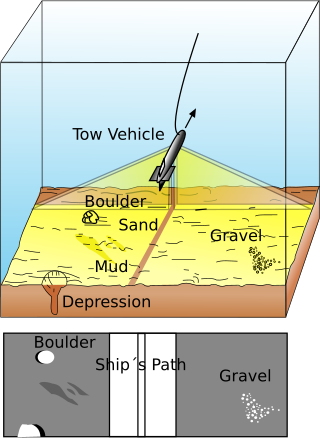
Side-scan sonar is a category of sonar system that is used to efficiently create an image of large areas of the sea floor.

Canada in the Cold War was one of the western powers playing a central role in the major alliances. It was an ally of the United States, but there were several foreign policy differences between the two countries over the course of the Cold War.

An autonomous underwater vehicle (AUV) is a robot that travels underwater without requiring continuous input from an operator. AUVs constitute part of a larger group of undersea systems known as unmanned underwater vehicles, a classification that includes non-autonomous remotely operated underwater vehicles (ROVs) – controlled and powered from the surface by an operator/pilot via an umbilical or using remote control. In military applications an AUV is more often referred to as an unmanned undersea vehicle (UUV). Underwater gliders are a subclass of AUVs.

The Monterey Bay Aquarium Research Institute (MBARI) is a private, non-profit oceanographic research center in Moss Landing, California. MBARI was founded in 1987 by David Packard, and is primarily funded by the David and Lucile Packard Foundation. Christopher Scholin serves as the institute's president and chief executive officer, managing a work force of approximately 220 scientists, engineers, and operations and administrative staff.

Unmanned underwater vehicles (UUV), sometimes known as underwater drones, are submersible vehicles that can operate underwater without a human occupant. These vehicles may be divided into two categories: remotely operated underwater vehicles (ROUVs) and autonomous underwater vehicles (AUVs). ROUVs are remotely controlled by a human operator. AUVs are automated and operate independently of direct human input.
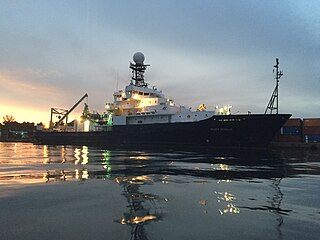
R/V Roger Revelle is a Thomas G. Thompson-class oceanographic research ship operated by Scripps Institution of Oceanography under charter agreement with Office of Naval Research as part of the University-National Oceanographic Laboratory System (UNOLS) fleet. The ship is named after Roger Randall Dougan Revelle, who was essential to the incorporation of Scripps into the University of California San Diego.

A multibeam echosounder (MBES) is a type of sonar that is used to map the seabed. It emits acoustic waves in a fan shape beneath its transceiver. The time it takes for the sound waves to reflect off the seabed and return to the receiver is used to calculate the water depth. Unlike other sonars and echo sounders, MBES uses beamforming to extract directional information from the returning soundwaves, producing a swathe of depth soundings from a single ping.
Geophysical MASINT is a branch of Measurement and Signature Intelligence (MASINT) that involves phenomena transmitted through the earth and manmade structures including emitted or reflected sounds, pressure waves, vibrations, and magnetic field or ionosphere disturbances.

The Ocean Observatories Initiative (OOI) is a National Science Foundation (NSF) Major Research Facility composed of a network of science-driven ocean observing platforms and sensors in the Atlantic and Pacific Oceans. This networked infrastructure measures physical, chemical, geological, and biological variables from the seafloor to the sea surface and overlying atmosphere, providing an integrated data collection system on coastal, regional and global scales. OOI's goal is to deliver data and data products for a 25-year-plus time period, enabling a better understanding of ocean environments and critical ocean issues.
Explorer autonomous underwater vehicle (AUV) is a Chinese AUV developed in the People's Republic of China (PRC), first entering service in November 1994. It should not be confused with another two Anglo-American AUVs that share the same name: the American Autonomous Benthic Explorer AUV (ABE) built by Woods Hole Oceanographic Institution, and the British Columbia-based International Submarine Engineering built Canadian Explorer AUV, which is based on its earlier ARCS AUV. Many Chinese AUVs later developed, such as Wukong, WZODA, CR series, Exploration series, Micro Dragon series, Sea Whale series, Submerged Dragon series AUVs, are all based on experienced gained from Explorer AUV.
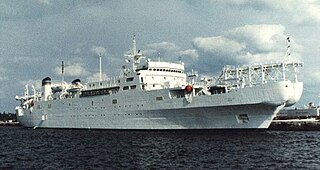
USNS Zeus (T-ARC-7) is the first cable ship specifically built for the United States Navy. Though planned to be the first of two ships of her class, the second ship was not built, leaving Zeus as the only ship of her class. She is capable of laying 1,000 miles (1,600 km) of cable at depths of up to 9,000 feet (2,700 m).

NOAAS Reuben Lasker is a National Oceanic and Atmospheric Administration (NOAA) fishery research vessel. The ship's namesake, Reuben Lasker, was a fisheries biologist who served with the Southwest Fisheries Center, National Marine Fisheries Service, and taught at the Scripps Institution of Oceanography.

The SeaFox is an anti-mine Unmanned underwater vehicle (UUV) manufactured by German company Atlas Elektronik. It is designed to locate and destroy ground and moored mines. There are three versions, including a training version. The orange SeaFox-I "inspection" variant has sonar and an Inertial navigation system, and the black SeaFox-C "combat" round also has a 1.4 kilograms (3.1 lb) shaped charge warhead. The system is in service with eleven navies. The SeaFox is an advanced design of an Expendable Mine Disposal Vehicle or EMDV. It has a low life cycle cost as it has low running and replacement costs. Its main targets are sea mines that pose a danger to vessels. It communicates with the ship via a fiber-optic cable. The SeaFox uses a custom launch and retrieval system, that may be fitted to a variety of ships, boats or even helicopters. It can be used for a range of tasks such as conduct damage estimation, route surveys, maritime boundary control, intelligence and harbor surveillance missions.
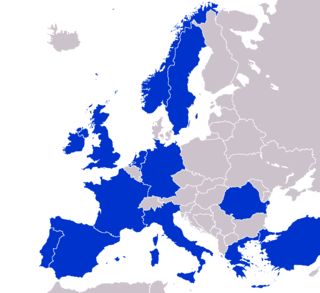
European Multidisciplinary Seafloor and water-column Observatory (EMSO) is a large-scale European distributed Research Infrastructure for ocean observation, enabling real-time interactive long term monitoring of ocean processes. EMSO allows study of the interaction between the geosphere, the biosphere, the hydrosphere, and the lithosphere; including natural hazards, climate change, and marine ecosystems. EMSO nodes have been deployed at key sites in European seas, starting from the Arctic, through the Atlantic and Mediterranean, to the Black Sea.

The National Science Foundation's (NSF) Ocean Observatories Initiative (OOI) Regional Scale Nodes (RSN) component is an electro-optically cabled underwater observatory that directly connects to the global Internet. It is the largest cable-linked seabed observatory in the world, and also the first of its kind in the United States.

RSVNuyina is an icebreaking research and supply vessel intended to support Australian scientific activities and research bases in Antarctica. Capable of deploying a wide range of vehicles, including helicopters, landing barges and amphibious trucks to support the resupply operation, the new ship provides a modern platform for marine science research in both sea ice and open water with a large moon pool for launching and retrieving sampling equipment and remotely operated vehicles.
Hadal 1 ARV is a type of very little known unmanned underwater vehicle (UUV) built in the People's Republic of China (PRC). ARV stands for Autonomous Remotely-controlled Vehicle, an idea pioneered in China by Shenyang Institute of Automation (SIA) of Chinese Academy of Sciences (CAS), and SIA is also the developer of Hadal 1 ARV, and its predecessor Hadal ARV, as well as Arctic ARV, the predecessor of Hadal ARV. Hadal 1 and its predecessor Hadal, and earlier Arctic series ARVs are the Chinese counterparts of Nereus hybrid unmanned underwater vehicle (UUV), because just like Nereus hybrid UUV, these ARVs can operate both as a AUV or a ROUV. The general designer of Hadal 1 ARV is Mr. Tang Yuan-Gui (唐元贵).
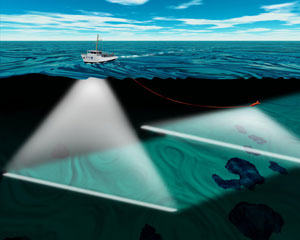
An underwater survey is a survey performed in an underwater environment or conducted remotely on an underwater object or region. Survey can have several meanings. The word originates in Medieval Latin with meanings of looking over and detailed study of a subject. One meaning is the accurate measurement of a geographical region, usually with the intention of plotting the positions of features as a scale map of the region. This meaning is often used in scientific contexts, and also in civil engineering and mineral extraction. Another meaning, often used in a civil, structural, or marine engineering context, is the inspection of a structure or vessel to compare actual condition with the specified nominal condition, usually with the purpose of reporting on the actual condition and compliance with, or deviations from, the nominal condition, for quality control, damage assessment, valuation, insurance, maintenance, and similar purposes. In other contexts it can mean inspection of a region to establish presence and distribution of specified content, such as living organisms, either to establish a baseline, or to compare with a baseline.
Autonomous Benthic Explorer (ABE) was a pioneering autonomous underwater vehicle (AUV) owned and operated by Woods Hole Oceanographic Institution (WHOI) in Woods Hole, Massachusetts. ABE was designed to perform wide-area seabed surveys at depths of up to 4500m (14,674ft) and completed 222 missions from 1996 until it was lost at sea in 2010. ABE pioneered the use of a relatively simple AUV to perform wide area surveys, identify points of interest, and “scout” for a more sophisticated manned vehicle or ROV.
















